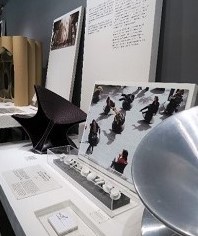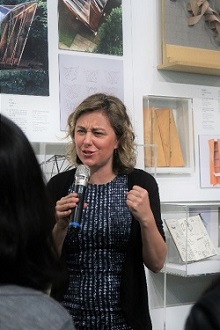Taipei Fine Arts Museum (TFAM) presented its series of architectural exhibitions New British Inventors: Inside Heatherwick Studio, as an extension of its dedication over the past decades to introduce classic contemporary architectural designs and masterpieces by critically-acclaimed designers worldwide.
This exhibition was curated by Kate Goodwin, Head of Architecture and Drue Heinz Curator at the Royal Academy of Arts, London. OISTAT Headquarters was invited by the British Council to interview Kate Goodwin to have a glimpse of the spirit of the exhibition.

Curator: Kate Goodwin.
Photo credit: Taipei Fine Arts Museum
The process: Thinking, Making and Story-Telling
For Kate Goodwin, selecting the work was the most difficult part of this exhibition because the studio has so many works. She decided to focus on process and select fewer projects, only 28 of them, each with more details. The name of the exhibition, Inside Heatherwick Studio, reflects how Kate Goodwin reveals the working process inside the studio. “I came up with the idea of three sections: Thinking, Making and Story-Telling, as the key aspects of the show. For me, it's about observing how the Studio works, how they apply to different projects. The projects themselves show what extraordinary works they are. Understanding the process makes the works even more extraordinary,” said Kate Goodwin.

Spun Chair. Image Credit: Magis
The Thinking was about the importance of having a key idea which is essential to the project, and about questioning what that idea is. When designing a project for a client, Heatherwick and his team would start by analyzing the brief. Sometimes they challenged what the brief said and asked questions to themselves. This critical process happened throughout the design.
The Studio asks questions that spark new ideas, taking convention and turning it upside down to look at it. They usually find an idea and then interrogate it again. For the signature work the Spun Chair, Heatherwick asked: “If it was possible to make large drums with spun metal, might it be possible to make a chair with a completely symmetrical rotational form? And would it be comfortable to sit in?”

Goodwin shared her observation on Heatherwick. “I had this image of Thomas, he will pick up something, look at it and feel it.” The importance of Making went back to Heatherwick’s studies of 3 dimensional design. Heatherwick is always curious about materials, that built his ability to create sculptural forms in his mind with his hands. The final section was Story-Telling; visitors will understand what the project is about when seeing how the idea is within the form. Taking the UK Pavilion for example, its story is in its form. One does not need the text to feel the magic of the building.

UK Pavilion, Shanghai. Shanghai World Expo, China, 2010. Image Credit: Iwan Baan, 2010.
The competition to design the United Kingdom’s pavilion in 2010 World Expo, held in Shanghai, China, was won by a team led by Heatherwick Studio. Heatherwick Studio received only half the budget other countries did to build the UK Pavilion. In addition, the UK government required that the UK’s pavilion to be on the list of the expo’s “top five” most popular attractions. To satisfy this expectation, Heatherwick Studio came up with the idea of Seed Cathedral. This fury building eventually won the gold medal of pavilion design.
Walking Through the Exhibition: When Form and Idea Come Together
Each of the works selected by Goodwin was placed in three sections: Thinking, Making and Story-telling. “What the Studio does is to come up with an original idea and embody it in some sort of form. For me, the strongest projects are those which the idea and its form come together in a very closely knit.” She hopes that those who come to the exhibition could think about all the aspects of each project.
What makes Heatherwick’s work so unique?
“Heatherwick’s Studio work across many disciplines, from product design, furniture design, sculptural work to architecture and infrastructure such as bridges and buses. They defy categorization. Their work is hard to put in any one box and is continuously surprising; I think these aspects are very intriguing,” Goodwin pointed out.
Another aspect, as Goodwin showed throughout the exhibition, is that Heatherwick Studio applied a very similar process across the typology and scale of all projects. From designing a chair to a building, the starting points are similar. The studio always pushes it beyond what you think: when you think this is the limit, they push it into something else. It is always something new and they take it to another level.”
When designing project in large scale, Heatherwick is different from most architects because of his strong conceptual ideas. “Heatherwick holds more strongly to a conceptual idea, whereas most architects think practically and rationally,” said Kate Goodwin. He would seek an idea and then give it a form. Most architects think about the functionality or spatial starting point and then grow it. Furthermore, he thinks very well on a macro-scale, such as a building and its urban surroundings; he also thinks very much about the small details, about handrail, surfaces and so on.

New Bus for London. Image Credit: Iwan Baan, 2012.
Daylight challenges at Taipei Exhibition
Inside Heatherwick Studio was held at Gallery 3C in Taipei Fine Arts Museum. Different from the atrium space in former venues it toured, Gallery 3C is a square shaped corridor which presented the works against the wall. “I like it here where the works are against the wall. It makes you walk down and go through a journey. I like the space very much,” said Goodwin. People go through a journey to see how Heatherwick Studio works on a project. Because of the huge windows in the gallery, the over bright daylight is problematic. To make the works brighter and more conspicuous, the team had to add a few more lights before the exhibition opens. The exhibition was also designed by the Studio.

Kate Goodwin Welcomes the Discussion between Architecture and the Arts
With her background in architecture, Kate Goodwin thinks that architecture had been more traditionally aligned with the arts—master builders were doing crafts before it became a profession. When the Royal Academy of Art was founded by artists and architects in 1768, those two professionals were part of the same community. It was only after the 20th Century that they separated, and architects moved more towards scientists. In late 20th Century architecture became more associated with the arts. There is always been some relationship between the two. Now architecture talks more about aesthetics, beauty and the arts. A lot of discipline boundaries have been broken down. Artists work across different fields; designers are working on products, films and new media.
Concerning that architecture and the arts are coming back together, Kate Goodwin welcomes the discussion between the two: “I think seeing architecture as pure science doesn’t align…, I see it more towards humanity; it’s a social art. It is not just art for art’s sake, it is about what it can do for the society. The trend towards art is good, but keeping it within a social sphere is positive; it is not just for itself, but it serves us humans.”
At the end of the interview, Kate Goodwin suggested junior curators who want to establish a career to be curious and passionate: “If you are curious, you look around and you can learn a lot from what you see; and it’s about things you care about and are passionate about, so that you inspire other people about that.”

More about Kate Goodwin
Kate Goodwin is Head of Architecture and Drue Heinz Curator at the Royal Academy of Arts. Most recently she curated the renowned exhibition Sensing Spaces: Architecture Reimagined, (January – April 2014) in the Main Galleries of the Royal Academy. Goodwin has also curated the exhibitions Constructed Landscapes (2011), Relics of Old London: Photography and the spirit of the city (2010), Andrea Palladio through the eyes of contemporary architects (2009) and Paper City: Urban Utopias (2009). She is the author of Dandelion: the making of the UK pavilion (2011), a book about Thomas Heatherwick’s UK pavilion at the Shanghai World Expo. She was awarded a RIBA Honorary Fellowship in 2016 in recognition of her contribution to the architecture profession.